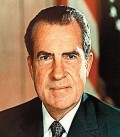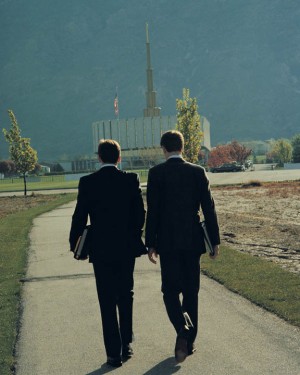As the 1970s began, the atmosphere at Church headquarters was very relaxed and open. There was no receptionist in the foyer of the Church Administration Building; individuals could simply walk in and announce themselves at offices. This carefree era was at an end, however. As more people voiced their discontent and anger at the United States’ war with Vietnam, people began acting out in various ways, not the least of which was violence. This led to tighter security at all Church buildings, but especially headquarters. Now all visitors must be scheduled and announced.
When Joseph Fielding Smith became the president of the Church, missionary work was encouraging Church growth, and as proselytizing was bringing in more converts, public opposition (especially from pastors of other churches whose flocks were beginning to shrink) also grew. Enemies of the Church began to look for any excuse to turn the public opinion against it. Political fringe groups were also using the societal tension to push their own agendas, and one such group, composed of college-age, African-American athletes, protested against Brigham Young University, claiming BYU was discriminating against African Americans. As it became clear, however, that BYU accepted all races into its student body, this group began to emphasize the policy of The Church of Jesus Christ of Latter-day Saints which prohibited anyone of color holding the priesthood. Political tensions grew as university students encouraged their universities to refuse to play BYU in sports until the Church policy was changed and all men were permitted to hold the priesthood. As evidenced in the anti-Mormon fight against polygamy in the 1800’s, however, outside pressure cannot change the commandments of God; only God can change His commandments to His people at any given time. Though both the practice of polygamy and the policy of who would be counted worthy to receive the priesthood were changed, it was not because of public pressure. The Saints follow the commandments of God until God changes them, not until it becomes inconvenient or unpopular to obey.
Out of this turmoil rose some good, however. President Joseph Fielding Smith recognized that the Church was growing and that it would be evermore in the media. He realized people with skills in this area should be called to help organize a publicity department to deal with publicity issues which would arise in the future. The Department of External Affairs (now the Public Affairs Department) was organized to act as liaison between Church leaders and the general public. This department was blessed with the advancement of technologies which allowed them to begin to use mass media more effectively to promote the Church. Even within the Church, mass media began to be used to reach Church members worldwide more quickly and more effectively through the use of periodicals, radio, television, and now the Internet. The Church has published several periodicals in its time to reach both Mormons and non-Mormons, striving to reach across illogical prejudice to teach the truths about its beliefs and the truths of the gospel of Jesus Christ.
President Smith was also instrumental in forming many Church administration departments, including the Auditing Department; the Budget Office; the Church Educational System; and the Correlation, Curriculum, Finance, Genealogical, Historical, Personnel, Building, Welfare, Investment, and Missionary Departments. In addition to these departments, several small groups were organized to help prepare, translate, and distribute Church curriculum materials, because worldwide Church growth means more languages which the members are speaking. The Church continues to strive to have all material available in all languages spoken by its members. With such a large, multi-faceted organization, many people wonder how the Church can still function. All the departments in the Church are ultimately responsible to the president, the prophet, who is privy to direct revelation from the Lord. Thus it is in fact Jesus Christ, not even the prophet, who is the head of The Church of Jesus Christ of Latter-day Saints. It truly is His church. There is no other way the Church could function at the magnitude it does.
 As the Church gained strength and numbers, it began to be recognized as a valuable tool by politicians. Senator Kennedy and President Nixon both called on the First Presidency in Salt Lake City. However, from the time Utah became a state, the Church has distanced itself more and more from politics. Upon the Saints’ first arrival in the Utah territory, there was no other government for them than the Church. As they were isolated and believed all things should be dedicated to the building up of the kingdom of God, they felt it only right that Church and government be intertwined. However, as more settlers arrived who were unaffiliated with the Church, it became less effective for this method to continue, since new settlers did not feel the same. After Utah finally gained statehood, though individual Mormons have held government positions, the Church as a whole has distanced itself from politics, affirming the rightness of the separation of Church and state. The Church has continued in this attitude, not getting involved in politics, unless there is a moral issue at hand which Church leaders feel must be addressed. Public officials who have tried to use the Church to gain votes have found continually that the Church will never endorse a public official, but encourages its members to be involved in their communities and to vote how their minds and consciences tell them to.
As the Church gained strength and numbers, it began to be recognized as a valuable tool by politicians. Senator Kennedy and President Nixon both called on the First Presidency in Salt Lake City. However, from the time Utah became a state, the Church has distanced itself more and more from politics. Upon the Saints’ first arrival in the Utah territory, there was no other government for them than the Church. As they were isolated and believed all things should be dedicated to the building up of the kingdom of God, they felt it only right that Church and government be intertwined. However, as more settlers arrived who were unaffiliated with the Church, it became less effective for this method to continue, since new settlers did not feel the same. After Utah finally gained statehood, though individual Mormons have held government positions, the Church as a whole has distanced itself from politics, affirming the rightness of the separation of Church and state. The Church has continued in this attitude, not getting involved in politics, unless there is a moral issue at hand which Church leaders feel must be addressed. Public officials who have tried to use the Church to gain votes have found continually that the Church will never endorse a public official, but encourages its members to be involved in their communities and to vote how their minds and consciences tell them to.
 President Smith’s administration was effective in promoting worldwide Church growth and effective media communication. He directed the organization of many departments which could function independently in their spheres, while still reporting to the president. The Church had grown far beyond the capacity of one man to micro-manage. Delegation is key to the functioning of the Church, which delegation ultimately comes from the Lord. President Smith understood this, as does the prophet today.
President Smith’s administration was effective in promoting worldwide Church growth and effective media communication. He directed the organization of many departments which could function independently in their spheres, while still reporting to the president. The Church had grown far beyond the capacity of one man to micro-manage. Delegation is key to the functioning of the Church, which delegation ultimately comes from the Lord. President Smith understood this, as does the prophet today.
Two more temples were dedicated under Joseph Fielding Smith in 1972, both of them in Utah. The Ogden Utah Temple was dedicated January 18 through 20 and the Provo Utah Temple was dedicated February 9. Since the vast majority of the Saints resided in Utah at this time, it made sense to have multiple temples for them to do work in.
Twitter •


 Watch a video about the restoration of the gospel on lds.org
Watch a video about the restoration of the gospel on lds.org